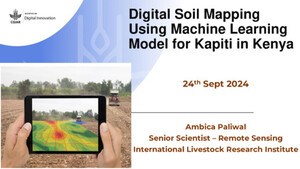
Communicating complexity: Integrated assessment of trade-offs concerning soil fertility management within African farming systems to support innovation and development
Abstract
African farming systems are highly heterogeneous: between agroecological and socioeconomic environments, in the wide variability in farmers’ resource endowments and in farm management. This means that single solutions (or ‘silver bullets’) for improving farm productivity do not exist. Yet to date few approaches to understand constraints and explore options for change have tackled the bewildering complexity of African farming systems. In this paper we describe the Nutrient Use in Animal and Cropping systems – Efficiencies and Scales (NUANCES) framework. NUANCES offers a structured approach to unravel and understand the complexity of African farming to identify what we term ‘best-fit’ technologies – technologies targeted to specific types of farmers and to specific niches within their farms. The NUANCES framework is not ‘just another computer model’! We combine the tools of systems analysis and experimentation, detailed field observations and surveys, incorporate expert knowledge (local knowledge and results of research), generate databases, and apply simulation models to analyse performance of farms, and the impacts of introducing new technologies. We have analysed and described complexity of farming systems, their external drivers and some of the mechanisms that result in (in)efficient use of scarce resources. Studying sites across sub-Saharan Africa has provided insights in the trajectories of change in farming systems in response to population growth, economic conditions and climate variability (cycles of drier and wetter years) and climate change. In regions where human population is dense and land scarce, farm typologies have proven useful to target technologies between farmers of different production objectives and resource endowment (notably in terms of land, labour and capacity for investment). In such regions we could categorise types of fields on the basis of their responsiveness to soil improving technologies along soil fertility gradients, relying on local indicators to differentiate those that may be managed through ‘maintenance fertilization’ from fields that are highly-responsive to fertilizers and fields that require rehabilitation before yields can improved. Where human population pressure on the land is less intense, farm and field types are harder to discern, without clear patterns. Nutrient cycling through livestock is in principle not efficient for increasing food production due to increased nutrient losses, but is attractive for farmers due to the multiple functions of livestock. We identified trade-offs between income generation, soil conservation and community agreements through optimising concurrent objectives at farm and village levels. These examples show that future analyses must focus at farm and farming system level and not at the level of individual fields to achieve appropriate targeting of technologies – both between locations and between farms at any given location. The approach for integrated assessment described here can be used ex ante to explore the potential of best-fit technologies and the ways they can be best combined at farm level. The dynamic and integrated nature of the framework allows the impact of changes in external drivers such as climate change or development policy to be analysed. Fundamental questions for integrated analysis relate to the site-specific knowledge and the simplification of processes required to integrate and move from one level to the next.
Citation
Giller, K.E.; Tittonell, P.; Rufino, M.; Wijk, M. van; Zingore, S.; Mapfumo, P.; Adjei-Nsiah, S.; Herrero, M.; Chikowo, R.; Corbeels, M.; Rowe, E.C.; Baijukya, F.; Mwijage, A.; Smith, J.; Yeboah, E.; Burg, W.J. van de; Sanogo, O.M.; Misiko, M.; Ridder, N. de; Karanja, S.; Kaizzi, C.; K’ungu, J.; Mwale, M.; Nwaga, D.; Pacini, C.; Vanlauwe, B. 2011. Communicating complexity: Integrated assessment of trade-offs concerning soil fertility management within African farming systems to support innovation and development. Agricultural Systems 104(2):191-203.










